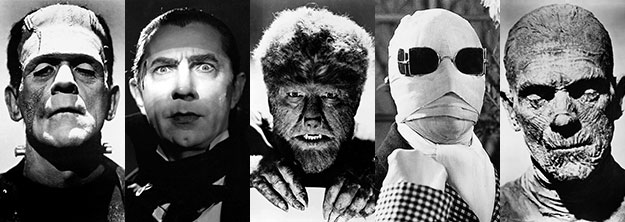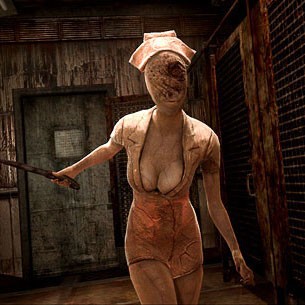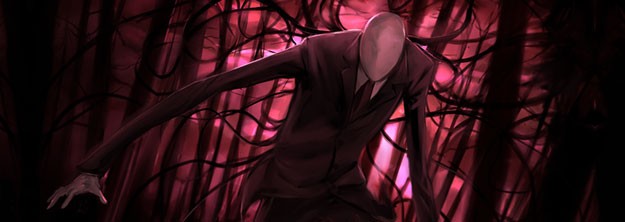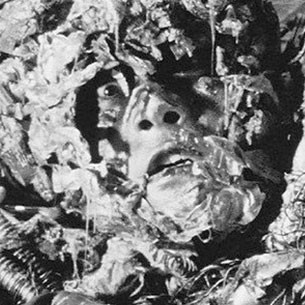AUTHOR’S NOTE: This remains one of my favorite articles I’ve ever written. It first saw the light of day in 2007. As any beloved horror creature worth its salt, it has managed to come back again and again, with small revisions over the years. I’m starting to accept my fate that this text, like some cursed passage from the pages of the Necronomicon, is destined to haunt me for eternity!
It’s that time of the year when chills are back in vogue. Both Halloween, which we borrow from North Americans, and the Day of the Dead, a Mexican holiday held in early November, pave the way for the exposure our deepest fears for the sake of fun. We do it with the help of horror costumes, movies, books and videogames: all our favorite sources of beloved horror and fright.
In short, humans love horror. The question is, why? What leads us to submit to such experiences, when they appear to be so unpleasant?
Fear, Inherited
First let’s establish what we mean by “horror”. The Royal Academy of Language in Spain defines it as “an intense feeling caused by a something terrible and awful, usually accompanied by trembling and fear.” The genre of horror is, therefore, the one whose stories provoke this feeling.
The building blocks of horror have existed since before the dawn of civilization. Ancient man, frightened by the natural occurrences of a world he could not fathom, attributed them to all sorts of creatures from deities to grotesque beasts sprung from his imagination with which he forged our first stories, fairy tales and belief systems. “[…T]he best selling book of all time, the Bible, could easily be labeled horror,” posit the members of the Horror Writers Association on their website. “[…W]here else can you find fallen angels, demonic possessions, and an apocalypse absolutely terrifying in its majesty all in one volume?”
However, the genre itself hadn’t been established until the late 18th century with the arrival of so-called gothic novels, literary works that explore both physical and psychological terror, using the castles and imposing structures of gothic architecture as the backdrop of mysterious supernatural events. Although The Castle of Otranto by Horace Walpole is generally regarded as the first gothic book, other works were more successful in popularizing these stories of fear around the world, the standouts being Mary Shelley’s Frankenstein, Bram Stoker’s Dracula and the works of Edgar Allan Poe.
Creeping Shadows
Cinema, after establishing itself as an effective medium for storytelling, began presenting lurid stories during its silent infancy. Le Manoir du diable by Georges Méliès is considered the first silent film horror, but the most striking of that era is possibly Nosferatu by FW Murnau, a loose interpretation of Stoker’s vampire tale.

The advent of sound opened the possibilities of increasing tension in films by using sound and music to create atmosphere. Universal Pictures were the masters of terror at that time, adapting gothic works such as Dracula, The Invisible Man and Frankenstein and bringing to lie other mythological creatures in movies like The Mummy and The Wolf Man.
In every subsequent era afterwards, horror film and literature has reflected the fears and anxieties of its generation. The Fifties introduced aliens and atomic mutations. During the Sixties, it was psychopaths, ghosts and zombies. The Seventies brought us demonic horror, sea beasts and the unstoppable masked murderer. Horror from the Eighties until today offers variations of all these themes, sometimes as satire, other times realistically, but almost always in excess.
The Great Divide
We are then left on one side with overly graphic stories, like Friday The 13th, The Texas Chainsaw Massacre and A Nightmare on Elm Street. While on the other are the tales that leave almost all terror to the imagination, such as Rosemary’s Baby, Stephen King books and some of their adaptations. Each side has its advocates, but the best of these stories are usually a combination of both, like The Exorcist, Psycho, The Shining, The Conjuring and The Silence Of The Lambs. There are also good examples of this in the television shows such as American Horror Story, Hannibal and The Walking Dead.

in the Silent Hill game series.
(SOURCE: Konami.)
With today’s advanced technology it’s even possible to dwell within our own horror narratives. Games like Dead Space, Resident Evil, Left 4 Dead, Fatal Frame, BioShock, Amnesia, F.E.A.R., Alan Wake, Dead Rising, The Evil Within, Five Nights at Freddy’s and Outlast allow us to inhabit, and survive, our worst nightmares.
Facing Your Fear
However, what motivates common, non-threatening, law-abiding folk to read HP Lovecraft? To visit Silent Hill? To immerse their ears in the aural nightmares of The NoSleep Podcast? To bear witness to Chucky, Freddy, Michael Myers, Jason, Jigsaw or Hannibal Lecter, all alone in the dark?
For James Cameron – director of Aliens, The Terminator and Avatar – the answer is in our past. “Our ancestors were survivors, therefore we’re here. An so there’s something plugged into our reptilian hindbrain that makes us relate to the idea of being pursued”, the filmmaker explains. “So we get to go on the kind of cathartic simulator runs[…] and we get to experience that heart-pounding fear of being chased”.
It’s a satisfying rush and it’s even better when shared. Screenwriting mentor Robert McKee understands that horror, like other genres, benefits from the intimate experience of watching a film in a group setting. “Filmgoers do not defend their emotions, rather they open to the storyteller in ways even their lovers never know, welcoming laughter, tears, terror, rage, compassion, passion, love, hate – the ritual often exhausts them”.
Lessons Learned
Although sometimes I may not appear as such, many of these scary stories have an intellectual appeal as cautionary tales or social commentary. Frankenstein, for example, is a warning against the excesses of science; vampires and slasher killers represent diseases and the hidden dangers of teenage sex, while Dawn Of The Dead es una crítica al consumismo. is a critique on consumerism. Meanwhile, all versions and sequels of The Thing and Invasion of the Body Snatchers are rooted in fears of the communist “threat” of the early fifties. The Cabin in the Woods, a more recent release courtesy of Joss Whedon (The Avengers) and Drew Goddard (Cloverfield), has no such allusions, but aims to be the definitive horror film whose plot justifies the need for all of the above. It serves both as a love letter and a deconstruction of the genre itself.

Compelled to Spook
Interestingly enough, Alfred Hitchcock saw horror as a public service. “I am to provide the public with beneficial shocks. Civilization has become so protective that we’re no longer able to get our goose bumps instinctively”, said the master of suspense. Serving chills on a plate to the viewer was a real treat for the director of Psycho. “I enjoy playing the audience like a piano” is one of his most famous quotes. Two films about the director, Hitchcock and The Girl, were released in 2012 and both refer to the renowned British filmmaker’s alleged desire of manipulation or abuse.
Which brings about another concern: what motive leads creators to choose this particular genre to tell their stories. Far from romantic reasons, the main consideration is money, as horror has a loyal, pre-established fanbase. “Young males, and sometimes women, too, are high sensation seekers – people who enjoy intense experiences”, explained Marvin Zuckerman, Professor Emeritus, University of Delaware known for his psychological dissertations on thrill seeking.
The audience members’ tastes becomes more sophisticated as they age, but they still pursue to experience fright up close, albeit in a more internal fashion. These sensation speakers can effectively “put themselves in the characters’ shoes while taking in the chilling story”, as Zuckerman puts it, and feel that heart-pounding fear of our ancestors in a safe simulator run according to Cameron. That explains why such renowned directors as James Mangold (Identity), Guillermo del Toro (Pan’s Labyrinth; Crimson Peak), David Fincher (Zodiac) or Alfonso Cuarón (Gravity) just can’t resist to revisit horror.
Homebrew Horror
When Bruce Campbell and Sam Raimi decided to make movies, they noticed that few beloved horror films containing “‘name’ actors, fancy clothes or exotic locations” that would increase a budget, according to Campbell’s biography If Chins Could Kill. This motivated them to produce The Evil Dead, now a cult classic along with its sequels. Raimi, today a prestigious filmmaker thanks to the Spider-Man trilogy, still feels the need to scare (see Drag Me to Hell) Recently he produced a remake of his original Evil Dead concept, directed by Fede Álvarez. He even teamed up with Campbell again to revive his creations on television in the show Ash vs. Evil Dead.

In the case of Dominican cinema, Rogert and Frankeli Bencosme also chose the horror genre for economic reasons. They thought first of producing a comedy but rejected the idea after discovering the profit margins that horror could throw their way, which reminded Frankeli of an urban myth about a girl possessed in rural Moca. So it went that they raised 100,000 dollars and went to the countryside. The result was Andrea. De forma similar, el director Francisco Disla confió en el éxito financiero de una película de miedo en el mercado dominicano. Inspirado en las atrocidades verdaderas cometidas en el país durante la dictadura de Rafael Leonidas Trujillo y en leyendas coloquiales como la de Papá Liborio, Disla nos ofreció El hoyo del Diablo (The Devil’s Hole) in 2012, the most recent Dominican feature within the genre.
Rite of Passage
Horror is also a common strategy for young writers and directors to get noticed. Steven Spielberg began his career by directing the TV movie Duel, a variation on the genre which tells the story of a driver pursued on the highway by a mysterious truck. The talent and resourcefulness he showed in that production got him his first big gig: Jaws, pioneer summer blockbuster and one of the most beloved horror films ever.
Current scare masters abound aplenty. Eli Roth (Hostel). James Wan (Insidious; The Conjuring). Oren Peli (Paranormal Activity). Jaume Collet-Serra (Orphan; The Shallows). Scott Derrickson (Sinister). Rob Marshall (The Descent). Jaume Balagueró ([REC]), Alexandre Aja (Piranha 3D). David Robert Mitchell (It Follows). Adam Green (Frozen). William Brent Bell (The Boy). Anthony Scott Burns (the creepy ‘Father’s Day’ segment from Holidays). The team behind Southbound and the V/H/S series. They are among the filmmakers of the current generation of fear that will do anything to stand out.
Shared Scare
It isn’t always about the big bucks, though. Beloved horror can be a social activity and the creative minds of the Internet are never far behind in digging up new characters and dark stories.
Take Reddit, for instance. Around 2010, a user named asmith1243 opened a section for scary stories inside that aggregator forum. He christened it, appropriately enough, r/NoSleep. The stories collected there garnered a cult following. This prompted Canadian redditor David “MikeRowPhone” Cummings to gather some of the members of that community and retell the best NoSleep stories in audio form. The NoSleep Podcast came as a result. One of the most venerable, lucrative and longest running horror fiction podcasts, it’s also one of my personal favorites. It’s currently in its eight season, having recently celebrated its fifth anniversary. Some of its talent has even branched out, as is the case of author Dathan ‘1000Vultures‘ Auerbach. He released his collected NoSleep stories as Penpal, a novel about a man realizing he was stalked throughout his childhood. The book has sold well and was even optioned by a Hollywood film producer.
Creature by Commitee
Here’s another good example of ghastly group creativity. In June 2009, a user known as Eric “Victor Surge” Knudson entered a photo manipulation competition on the Something Awful website. Surge tweaked some old pictures of children in the park and included a mysterious figure of exaggerated height and no facial features wearing a dress suit and sometimes showing tentacles. The character was an instant viral hit and was christened Slender Man. Other people on the web took it upon themselves to develop a mythology on this dark specter and even multiple long-running series on YouTube, The most famous one, Marble Hornets, tells the saga of a young man who investigates the appearance of the creature in the film footage shot by his missing friend.
“Slendy”, as his nickname goes, even has several free games under his belt including Slender where players must find the pages of a diary between dark forests and abandoned buildings before the monster catches them. In fact, Mark “AgentParsec” Hadley, the designer of the game, collaborated with Knudson, the character’s creator, as well as the writers of Marble Hornets on Slender: The Arrival, a reimagined, complete and interactive version of the faceless, feeble bodied and now legendary fiend. It can also be played using the Oculus Rift, a virtual reality PC accessory for those brave enough to confront the creature face-to-face.

Beloved Horror or Necessary Chills?
Experience has shown us that the more scares we get, especially with our entertainment media, the more we want them, to the point that we become desensitized to them. After seeing The Exorcist, Roger Ebert pondered: “Are people so numb they need movies of this intensity in order to feel anything at all?”
So we ask ourselves: is horror truly necessary? I suppose we may consider its “consumption” as a way to get to know our secret nature, channel our childhood fears or face our demons. It’s even likely that it may fill an emotional void in our daily lives.
But ultimately the reason each of us love horror is individual. What is certain is that it will always remain a popular genre.
Perhaps the best explanation is one Ebert gave, appropriately enough, in his review of the film Halloween. “Sometimes we want to be amused. Sometimes we want to escape. Sometimes we want to laugh, or cry, or see sunsets. And sometimes we want to be scared”.
Frightful Gems
| A few great picks of beloved horror from the past that still have the power to unnerve. |
 The lesser known and scariest entry of the J-Horror boom. |
 The inner longings of John Rainbird towards pretty pyromaniac Charlie are still quite disconcerting. |
 It may not be the newest or most gruesome kid in the block, but it’s ambience and Trent Reznor’s score are still hard to beat. Update it with a texture mod and see for yourself. |
An abridged version of this essay first appeared on the October 2007 issue of Revista U magazine, with a revised edition uploaded to their official website on October 24, 2013. This updated version includes more names of recent, interesting and beloved horror material. Click here for the original article (in Spanish).

